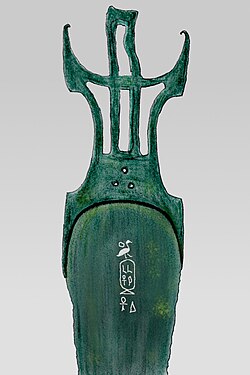| Seuserenre Bebiankh | |||||||||||||||||||||||||||||||||||||||||||
|---|---|---|---|---|---|---|---|---|---|---|---|---|---|---|---|---|---|---|---|---|---|---|---|---|---|---|---|---|---|---|---|---|---|---|---|---|---|---|---|---|---|---|---|
 Bronze dagger bearing the inscription "The son of Ra, Bebiankh, given life". British Museum EA 66062. | |||||||||||||||||||||||||||||||||||||||||||
| Pharaoh | |||||||||||||||||||||||||||||||||||||||||||
| Reign | 12 years 1603-1591 BC 1600-1588 BC | ||||||||||||||||||||||||||||||||||||||||||
| Predecessor | Semenre | ||||||||||||||||||||||||||||||||||||||||||
| Successor | Sekhemre Shedwaset or Pepi III (Helck) | ||||||||||||||||||||||||||||||||||||||||||
| |||||||||||||||||||||||||||||||||||||||||||
| Died | 1591 or 1588 BC | ||||||||||||||||||||||||||||||||||||||||||
| Dynasty | 16th Dynasty | ||||||||||||||||||||||||||||||||||||||||||
Seuserenre Bebiankh was a king in Upper Egypt during the Second Intermediate Period. He is often placed in the 16th Theban Dynasty and his prenomen or royal name is mentioned in the Turin King List with a reign of 12 years.
Based on an interpretation of the Turin King List, Bebiankh was succeeded either by a poorly known king named Sekhemre Shedwast.[1] Also suggested is the equally shadowy ruler Seneferankhre Pepi III.[2]
Attestations
[edit]Bebiankh is only attested in a small region of Upper Egypt.
At Gebel Zeit (Red Sea), a modest stela preserves his prenomen Seuserenre and nomen Bebiankh, attesting to mining activity in the nearby gelena mines.[3][4][5] Mining expeditions to Gebel Zeit often departed from Coptos (Quft), cf. Minemhat of Coptos.
At Medamud, he built an extension to the Temple of Mentu.[6]
In Naqada, the nomen of Bebiankh is found on a bronze dagger with the inscription: Son of Ra, Bebiankh, given life.[7][1]
Non-contemporary attestations
[edit]The Karnak King List from the time of Thutmose III mentions: 27. Se-user-en-re. Here he is between Nubkheperre and Senakhtenre.
The Turin King List 11:08 from the time of Ramesses II mentions: The Dual King Seuserenra reigned 12 years, months lost, x days.[8] In the list he is preceded by 11:07 Semenra and succeeded by 11:09 Sekhemre Shedwaset, often interpreted as chronological.
The name Seuserenre consists of word-components: s-wsr-n-r'
- wsr which means "powerful".[9]
- n can mean "of"
- r' refers to the sun-god Ra.
References
[edit]- ^ a b Kim Ryholt, The Political Situation in Egypt during the Second Intermediate Period c.1800-1550 B.C, Museum Tusculanum Press, (1997), p. 202
- ^ Wolfgang Helck, Eberhard Otto, Wolfhart Westendorf, Stele - Zypresse: Volume 6 of Lexikon der Ägyptologie, Otto Harrassowitz Verlag, 1986, Page 1383
- ^ Georges Castel & Georges Soukiassian: Dépôt de stèles dans le sanctuaire du Nouvel Empire au Gebel Zeit, BIFAO 85 (1985), ISSN 0255-0962, pp. 291–92, pl. 64
- ^ Ryholt, pp. 159–60
- ^ Janine Bourriau, "The Second Intermediate Period (c.1650-1550 BC)" in Ian Shaw (ed.) The Oxford History of Ancient Egypt, Oxford University Press, 2000. p.205
- ^ "XVIIth Dynasty". Archived from the original on 2014-02-01. Retrieved 2007-08-15.
- ^ British Museum EA 66062
- ^ https://pharaoh.se/turin-kinglist-column-11 Pharaoh.se
- ^ "WSR". 25 August 2023.